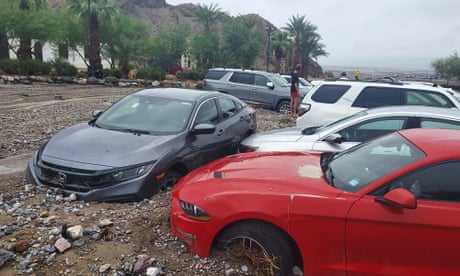Extract from The Guardian
Hundreds were marooned in the downpour as the climate crisis increases the likelihood of extreme weather.
Thu 11 Aug 2022 04.50 AEST
Last modified on Thu 11 Aug 2022 04.55 AESTThe arid valley was pelted with roughly an inch and a half of rain on Friday, near the park’s rainfall record for a single day.

The storm poured an amount of water equal to roughly 75% of the average annual total in just three hours, according to experts at Nasa’s Earth observatory. Hundreds visiting and working in Death Valley national park were marooned and all roads continue to be impassable, according to park officials.
The waters have receded, leaving behind thick layers of mud and gravel, but those who were stranded were able to exit the park earlier this week, aided by park service personnel.
Daniel Berc, a meteorologist with the National Weather Service Las Vegas, described the deluge as a historic “1,000-year event”, with a 0.1% likelihood during a given year.

But events like this one, once thought to be exceedingly rare, are on the rise. Scientists are finding that weather extremes, fueled by the climate crisis, are becoming more likely in the American west, which continues to be mired in drought. Periods of dryness are expected to be broken with strong, destructive storms as the world continues to warm.
No injuries have been reported but aerial searches are being conducted by the California highway patrol and naval aircraft, the National Park Service said in a statement, to confirm that vehicles are not still stranded in remote areas of the park.
In a statement, the park superintendent, Mike Reynolds, said it would “take time to rebuild” and noted that officials were still working to assess destruction from the storm across the roughly 3.4m acres and more than 1,000 miles of roads in the park.
While the storm did not break Death Valley’s all-time record for daily rainfall, it did break records for this time of year, as August generally produces just a tenth of an inch of rain.
Nasa satellites were able to capture the storm’s effects, showing a belt of blue across the typically brown terrain.
“This week’s 1,000-year flood is another example of this extreme environment,” Reynolds said. “With climate change models predicting more frequent and more intense storms, this is a place where you can see climate change in action.”
No comments:
Post a Comment